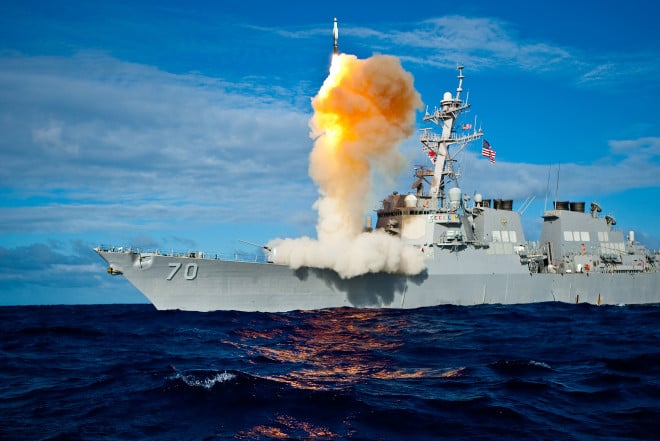
The U.S. Navy has placed an emphasis on ballistic missile defense and a commitment to a next-generation Littoral Combat Ship in its Fiscal Year 2014 draft 30-year shipbuilding plan obtained by USNI News on Tuesday.
The plan – which outlines the construction, delivery and retirement of the Navy’s ship and submarine inventory from Fiscal Year 2014 to 2043 – calls for the construction of 66 BMD ships starting in 2016 and 30 of a next generation LCS beginning in 2030.
The BMD ships will be variants of the current class of Arleigh Burke guided missile destroyers, according to the plan. The 33 Flight III ships – scheduled to begin construction in Fiscal Year 2016 – will be built around the Air and Missile Defense Radar.
Current Arleigh Burkes and Ticonderoga-class missile cruisers have undergone software modifications to allow the ships to use their Aegis missile systems to target and destroy rogue missiles and were recently employed to create a protective screen around the Korean peninsula.
Flight IIIs, with the AMDR, will be the first ship class tailored to the BMD mission.
The Navy canceled a next-generation cruiser in 2008 that would have filled the BMD role deeming the program too expensive. The Navy settled on the Flight III – built on the 1990s era hull design — as a lower cost alternative.
The plan also calls for a Flight IV Arleigh Burke with the first ship to be procured in 2030, however the Flight IV designation is likely a placeholder for a new class of ship to be developed for the BMD mission, according to several naval sources.
Also in 2030 the Navy plans to start procurement of LCS(X), the second generation Littoral Combat Ship. The Navy alluded to a follow-on class to the two LCS hulls the navy is currently buying last year, but the draft report puts an estimated date on construction of the next-generation of the class.
In the near term the Navy will buy the final of four Mobile Landing Platforms in 2014. Two will become part of a naval supply and logistics squadron and two will serve as Afloat Forward Stating Bases for mine countermeasure forces and special operations forces.
The Navy will continue to maintain carrier purchases at five-year intervals and continue two-a-year Virginia-class submarine buys well into the 2020s.
In amphibious shipping, the Navy will buy its first planned replacement of the Whidbey Island-class dock landing ships in 2019. The navy also plans to buy six America-class big deck helicopter carriers by 2043.
In total end strength, the Navy estimates it will reach its 300-ship goal by 2018 up from a planned total battle force of 282 ships in 2014.
The draft plan was released ahead of Wednesday’s hearing of Navy leaders before the House Armed Services Committee on Seapower and Projection Forces.





